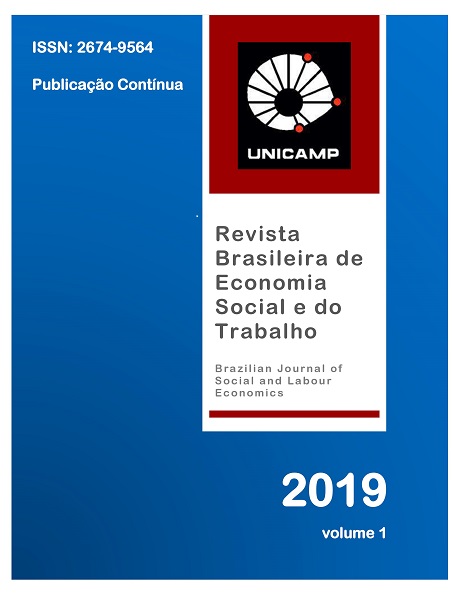Abstract
This paper deals with the long Italian economic crisis after the so-called “economic miracle”. The article reconstructs Italy's economic history and policies implemented from the 1970s until 2008, and then shows the effects of the 2008 crisis on the Italian economy. It critically discusses the policies implemented to address the crisis, in particular labour policies such as wage moderation, the weakening of collective bargaining and the deskilling labour supply, achieved also through continued fund reductions for public universities and research. Moreover, it analyses the dynamics of labour force and wages from 2008 to 2018. Taking into account the long economic stagnation and the current Italian productive structure, it concludes that Italy needs to rethink its industrial policies, considering the State as the innovator of first resort.
References
Bellofiore, R., & Vertova, G. (2014). Neoliberismo, ecosistema e sistemi nazionali di innovazione: verso uno Stato innovatore di prima istanza. La Rivista Delle Scienze Sociali, 4, 211-221.
Bhaduri, A., & Marglin, S. (1990). Unemployment and the real wage: the economic basis for contesting political ideologies. Cambridge Journal of Economics, 14(4), 375-393. Retreived from: https://www.jstor.org/stable/pdf/23598376.pdf?refreqid=excelsior%3Aea064872396ef1ff94bfec878660016e.
Bianchi, P. (2013). La rincorsa frenata. L’industria italiana dall’unità alla crisi globale. Bologna: Il Mulino.
Bianco, M. L., Contini, B., Negri, N., Ortona, G., Scacciati, F., Terna, P., & Togati, D. (2018, maggio 7). I pubblici dipendenti sono troppo pochi. [Bollettino Adapt, n. 17]. Estratto da: http://www.bollettinoadapt.it/wp-content/uploads/2018/05/I-pubblici-dipendenti-sono-troppo-pochi.pdf.
Birindelli, L. (2019). Retribuzioni e mercato del lavoro: l’Italia a confronto con le maggiori economie dell’Eurozona. [Laurea Triennale in Economia], Università degli Studi di Ferrara. Estratto da: http://www.unife.it/economia/economia/insegnamenti/economia-politica-i/materiali-corso-a-a2018-2019/retribuzioni-e-mercato-del-lavoro-l2019italia-a-confronto-con-le-maggiori-economiedell2019eurozona/201cretribuzioni-e-mercato-del-lavoro-l2019italia-a-confronto-con-le-maggiori-economiedell2019eurozona201d-di-lorenzo-birindelli-fondazione-giuseppe-di-vittorio-marzo-2019/view.
Caffè, F. (1972). La strategia dell’allarmismo economico. Giornale degli Economisti e Annali di Economia (Nuova Serie), 9(10), 692-699.
Crouch, C. (2009). Privatised Keynesianism: An unacknowledged policy regime. British Journal of Politics and International Relations, 11(3), 382-99. doi:10.1111/j.1467-856X.2009.00377.x.
De Cecco, M. (2012). Una crisi lunga mezzo secolo: Le cause profonde del declino italiano. Economia Italiana, 3, 69-92.
EUROSTAT (2018). The European economy since the start of the millennium — A statistical portrait — 2018 edition (4.4 Share of government employment nearly stable). Retreived from: https://ec.europa.eu/eurostat/cache/digpub/european_economy_2018/bloc-4d.html?lang=en.
Felettigh, A., & Stefano, F. (2011). Measuring the price elasticity of import demand in the destination markets of Italian exports. Economia e Politica Industriale, 38(1), 127-62.
Forges Davanzati, G., & Giangrande, N. (2017). Le politiche del lavoro e formative in Italia (2008-2015): un’analisi critica. In Amedeo Di Maio & Ugo Marani (a cura di). Politiche economiche e crisi internazionale. Uno sguardo sull’Europa (pp. 173-211). Roma: L'Asino d'Oro.
Forges Davanzati, G., & Mongelli, L. (2018). Does rising unemployment lead to policies of labour flexibility? The Italian case (1990-2013). Economia & Lavoro, 52(3), 15-28. doi:10.7384/92359.
Forges Davanzati, G., Patalano, R., & Traficante, G. (2019). The Italian economic stagnation in a Kaldorian theoretical perspective. Economia Politica, 36(3), 841-861. doi:10.1007/s40888- 017-0084-0.
Layard, R., Nickell, S., & Jackman, R. (1991). Unemployment: Macroeconomics performance and the labour market. Oxford: Oxford University Press.
Giangrande, N. (2016). As posições, as propostas e as ações da CGIL para combater o desemprego na Itália (2004-2013). (Dissertação de Mestrado). Universidade Estadual de Campinas, SP, Brasil. Retirado de: http://www.repositorio.unicamp.br/handle/REPOSIP/304743.
Giangrande, N. (2019, marzo 07). Una breve nota sul declino economico italiano: La moderazione salariale. Fondazione Giangiacomo Feltrinelli. Estratto da: http://fondazionefeltrinelli.it/una-breve-nota-sul-declino-economico-italiano-la-moderazione-salariale/.
Graziani, A. (2000). Lo sviluppo dell’economia italiana. Dalla ricostruzione alla moneta europea. Torino: Bollati Boringhieri.
Hein, E. (2017). The Bhaduri-Marglin post-Kaleckian model in the history of distribution and growth theories: An assessment by means of model closures. Review of Keynesian Economics, 5(2), 218-238. doi:10.4337/roke.2017.02.05.
ISTAT. 2019. Il mercato del lavoro 2018. Verso una lettura integrata. Roma: Istituto Nazionale di Statistica. Estratto da: https://www.istat.it/it/files//2019/02/Mercato-del-lavoro-2018.pdf.
Kalecki, M. (1968). The Marxian equations of reproduction and modern economics. Social Science Information, 7(6), 73-79.
Kalecki, M. (1971). Class struggle and the distribution of national income. Kyklos, 24(1), 1-9. doi:10.1111/j.1467-6435.1971.tb00148.x.
Mazzucato, M. (2014). Lo Stato innovatore. Roma-Bari: Laterza.
Paternesi Meloni, W. (2018). Italy’s price competitiveness: An empirical assessment through export elasticities. Italian Economic Journal, 4(3), 421-462. doi:10.1007/s40797-018-0075-5.
Perri, S., & Lampa, R. (2018). When small-sized and non-innovating firms meet a crisis: Evidence from the Italian labour market. PSL Quarterly Review, 71(284), 61-83. doi:10.13133/2037-3643_71.284_4.
Pesole, D. (2010, Aprile 30). L’autunno nero del ’92 tra tasse e svalutazioni. Il Sole 24 Ore. https://st.ilsole24ore.com/art/SoleOnLine4/Editrice/IlSole24Ore/2010/04/30/Economia%20e%20Lavor o/5_A.shtml?refresh_ce=1.
Streeck, W. (2014). The politics of public debt: Neoliberalism, capitalist development and the restructuring of the State. German Economic Review, 15(1), 143-165. doi:10.1111/geer.12032.
Tridico, P. (2015). From economic decline to the current crisis in Italy. International Review of Applied Economics, 29(2): 164-193. doi:10.1080/02692171.2014.983049.
Tronti, L. (2009). La crisi di produttività dell’economia italiana: Scambio politico ed estensione del mercato. Economia & Lavoro, 43(2), 139-157. doi:10.7384/70834.
All content of the journal, except where identified, is licensed under a Attribution-NonCommercial-ShareAlike 4.0 International. The Journal adopts the Open Access model, allowing anyone to download texts, read, copy and disseminate for academic purposes free of charge.

